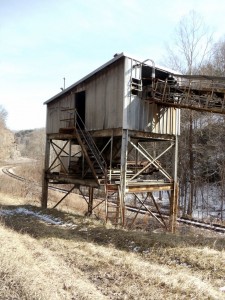- Size: 7′ x 11′
- Scale: N
- Minimum Radius: 15″
- Minimum Aisle Width: 28″
- Designed by Dan Bourque
 Few branches in the Appalachians saw more coal than the Clinchfield’s Fremont Branch. Like every other coal branch, it was lined with loaders of various sizes, but at the end of the branch lay the massive Moss No. 1 prep plant. There are many characteristics that made the Fremont Branch interesting. First, the profile of the branch climbed a ridgeline from the CRR main, punched through Bear Penn Gap Tunnel, and then descended most of the way to the end of the line at Moss. Second, Moss was a loads-in/loads-out operation. Because of the grades and heavy trains both ways, all “Moss Turns” required helpers in both directions. The line was served at least twice a day, routinely with 15,000 hp or more and heavy trains. Besides the trains, the branch offers a lot of scenic possibilities including creekside trackage, bridges and a tunnel.
Few branches in the Appalachians saw more coal than the Clinchfield’s Fremont Branch. Like every other coal branch, it was lined with loaders of various sizes, but at the end of the branch lay the massive Moss No. 1 prep plant. There are many characteristics that made the Fremont Branch interesting. First, the profile of the branch climbed a ridgeline from the CRR main, punched through Bear Penn Gap Tunnel, and then descended most of the way to the end of the line at Moss. Second, Moss was a loads-in/loads-out operation. Because of the grades and heavy trains both ways, all “Moss Turns” required helpers in both directions. The line was served at least twice a day, routinely with 15,000 hp or more and heavy trains. Besides the trains, the branch offers a lot of scenic possibilities including creekside trackage, bridges and a tunnel.
The Layout
This layout captures the major features of the Fremont Branch in only a little space. The centerpiece of the layout is the huge Moss No. 1 Prep Plant with its two yards for raw and processed coal, but several other of the branch’s loaders are represented to keep operations a little more challenging. Staging is ample with six tracks, though trains might have to double-out of staging to represent branch operations more faithfully. Besides operations, the layout offers some great opportunities for scenery modeling with Bear Penn Gap Tunnel, three creeks and bridges. Unfortunately, the scenery and loaders along the branch are all significantly compressed. There were several miles between Bear Penn Gap and Moss on the prototype, so the loaders were spread out. To get more operations into the layout, I had to compress the space between scenes, overlap some of the loader tracks and omit a couple of loaders. Still, the major features are present, and you could always eliminate a loader or two if you wanted more space between loaders. The raw coal yard at Moss stubs into the backdrop to save space, but there is still sufficient space at Moss to run-around and spot hoppers. Because of the helper operations, walk-around DCC control is almost a must.
Operations
This layout would be perfect for 2 operators. It can be operated just like the prototype (see Scott Jessee’s article “Clinchfield Operations on the Fremont Branch” for more information). The “1st Moss Turn” would leave Dante staging with head-end power, a long string of loaded hoppers, helper power, and a few empties bound for Lick Dock at Moss. After clearing Bear Penn Gap Tunnel, the crew would proceed to Moss where the helper crew would shove raw coal loads into the raw yard and empties into Lick Dock (because the helper is on the right end of the train for this) while the head-end crew would start gathering up processed loads. After the train is put together, the crew would leave Moss for Dante, gathering up loads from the smaller docks along the way. To get ready for the 2nd Moss Turn, the “raw loads” from 1st Moss would be run through the tipple and spotted in the processed coal yard as “processed loads.”
The 2nd Moss Turn would leave Dante with head-end power, a long string of loads, helper power, and a long string of empties. After clearing Bear Penn Gap Tunnel, the helper would detach from the loads with the empties and start placing empties at all the tipples along the branch. Meanwhile, the head-end crew would take the raw loads to Moss, run-around them, and set them in the raw yard before gathering up the processed loads and loads from Lick Dock. Once the helper crew and head-end crew completed their chores, the helpers would couple onto the rear of the train and the turn would proceed back to Dante. While it may not sound like much, each turn, and indeed each crew on the turn, would need to complete a lot of moves to make things work, and there is enough difference between the 1st and 2nd Moss Turns to keep the same operators interested enough to do work both assignments in one session.
Things I Like About this Plan:
- Lots of operation in a very small space
- Helpers
- Loads-in/loads-out avoids removing and adding loads during a session
- Great scenery possibilities for a branchline
- No duckunders
Things I Don’t Like About this Plan:
- Very compressed
- Staging might be too short
- Pinch-point in the aisle between Mullins and Moss
Related Products:





